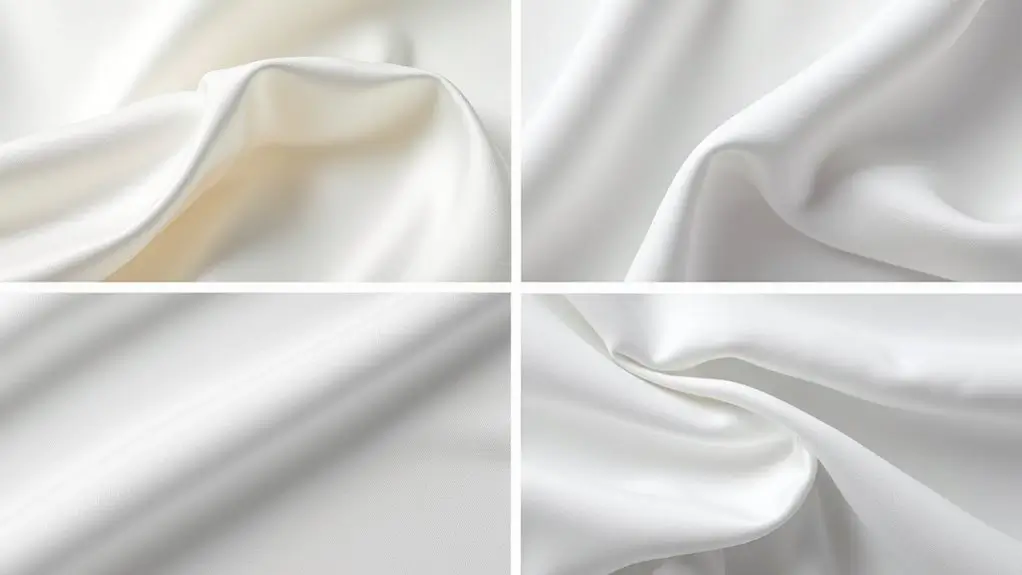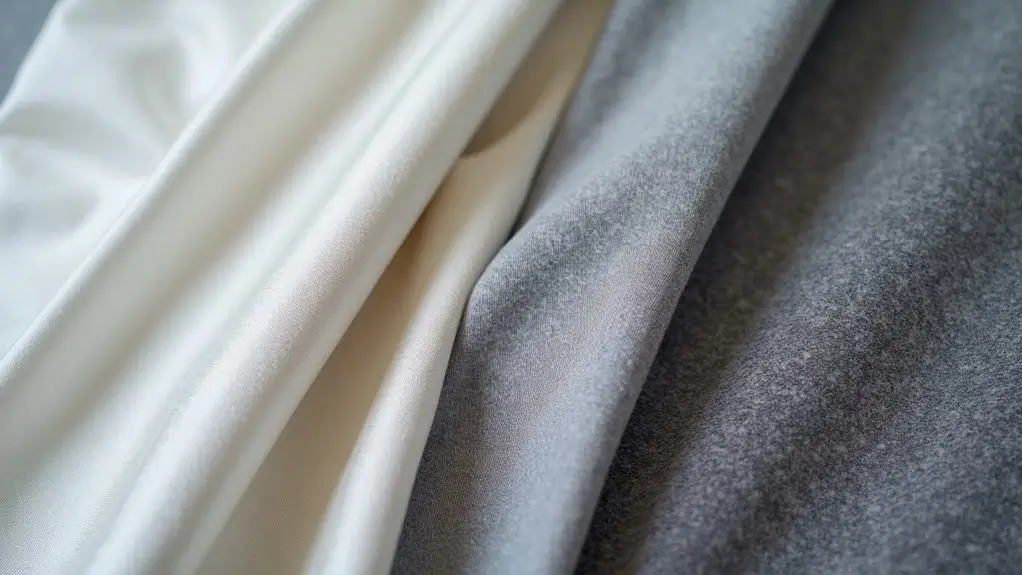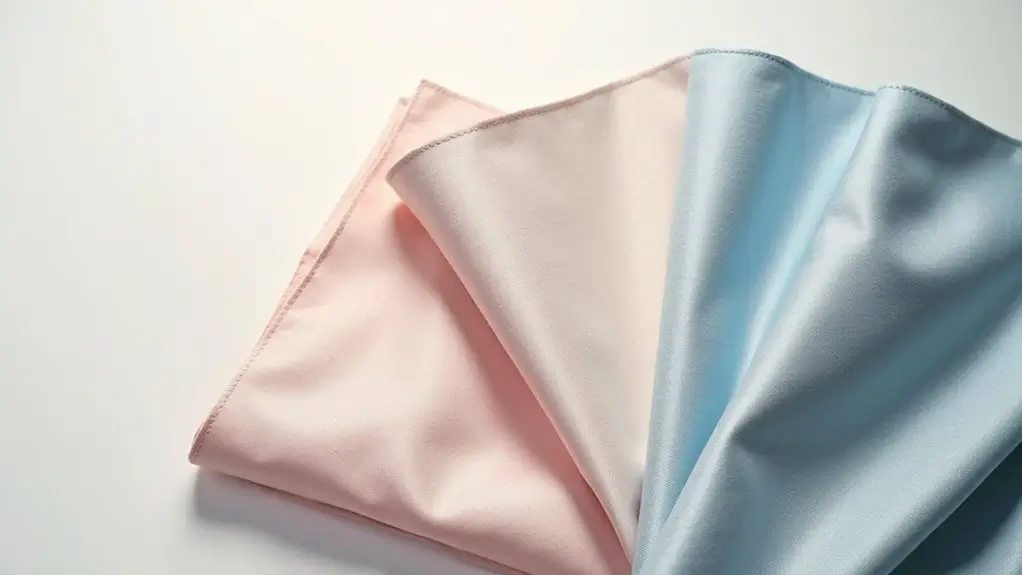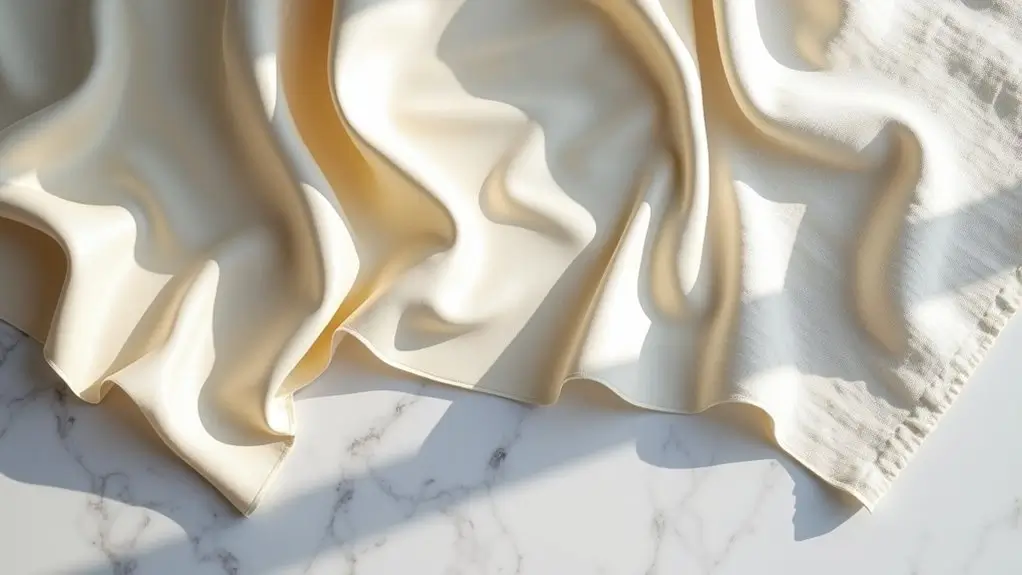When exploring polyester fabrics, you'll find a variety of engineered types. Today's manufacturing processes produce specialized materials like moisture-wicking microfiber, thermally efficient polar fleece, and sustainable rPET derivatives.
Each type has unique polymer structures and finishing treatments that affect its performance. Understanding these variations will help you choose the best polyester for your specific needs.
Key Takeaways
- Microfiber polyester measures less than one denier thick. It excels in moisture management, making it ideal for sportswear.
- Polar fleece delivers exceptional thermal regulation. It's lightweight and water-resistant, perfect for outerwear applications.
- Spun polyester offers enhanced softness and improved drape. It's created through staple fiber manipulation for comfort and durability.
- Recycled polyester (rPET) is made from post-consumer PET bottles. It maintains identical performance to virgin polyester.
- Blended polyester combines natural and synthetic fabric fibers for enhanced performance.
What Is Polyester Fabric?

Polyester fabric is a synthetic textile engineered through polymerization. It consists of long-chain polymers derived from petroleum-based components.
This synthetic material is made through a specific chemical reaction. It involves ethylene glycol and purified terephthalic acid, which create polyethylene terephthalate (PET) fibers.
The manufacturing process allows for versatile fiber characteristics. It produces different textures from coarse to smooth.
Polyester is not as soft as natural fibers. But it offers excellent durability, moisture resistance, and tear resistance. These make it ideal for diverse applications.
Its low production costs have made polyester a top synthetic material in global textile manufacturing.
9 Different Types of Polyester Fabric

Now, let's explore the various types of polyester fabric and their unique characteristics.
1. Microfiber Polyester
Microfiber polyester measures less than one denier in thickness. This type of fabric excels in moisture management. It can efficiently wick perspiration away from your skin through its ultra-fine fiber structure.
Its engineered composition delivers exceptional durability. Meanwhile, it can maintain dimensional stability through repeated washing cycles.
Its unique fiber construction enables superior stain resistance. So it requires minimal maintenance protocols.
2. Polyester Fleece
Polyester fleece is a soft, lightweight fabric with excellent insulation properties. This material traps heat effectively, making it ideal for cold-weather wear.
Its unique fiber structure allows for breathability. Meanwhile, it retains warmth, ensuring comfort during outdoor activities.
Polyester fleece is also highly resistant to shrinking and stretching. It can maintain its shape even after many washes.
Additionally, this fabric is quick-drying and moisture-wicking, keeping you dry and cozy. With its easy-care nature, polyester fleece requires minimal upkeep.
3. Spun Polyester
Spun polyester maintains exceptional durability. It also offers superior comfort characteristics compared to standard polyester fabrics. The manufacturing process involves fiber refinement. This results in enhanced softness and improved drape.
When blended with other fibers, spun polyester exhibits advanced moisture management properties. The fabric's versatility allows for various weight variations and textural modifications. This makes it ideal for both apparel and home textile applications.
Its wash-resistant qualities guarantee long-lasting performance throughout repeated laundering cycles.
4. Recycled Polyester (rPET)
As the textile industry shifts toward sustainability, recycled polyester (rPET) has become a game-changing innovation.
rPET production starts with collecting used PET bottles. These bottles are cleaned with specialized systems and turned into high-quality polyester fibers.
The resulting recycled polyester has the same performance characteristics as virgin polyester. It still has durability and moisture-wicking abilities.
What's remarkable is that this process considerably reduces landfill waste and carbon emissions.
rPET has become a cornerstone in circular textile manufacturing. It offers you the same technical benefits while supporting eco-conscious production methods.
5. Blended Polyester
Blended polyester fabrics combine synthetic and natural fibers like cotton. These textiles have enhanced performance characteristics.
Common variants include poly-cotton. It merges polyester's wrinkle resistance with cotton's breathability for ideal comfort and durability.
These engineered blends deliver superior color retention and dimensional stability. Meanwhile, they reduce production costs.
You'll see these versatile materials across fashion and home furnishing applications. They're valued for their balanced performance characteristics and cost-effectiveness.
6. Stretch Polyester
Stretch polyester delivers exceptional flexibility and shape retention. It's engineered with elastomeric fibers like spandex or elastase,
This specialized polyester variant incorporates strategic fiber blending. So it can achieve peak elasticity without compromising durability.
The fabric's moisture-wicking properties make it particularly effective for performance apparel. It can draw perspiration away from your skin during physical activity.
7. Polyester Satin
Polyester satin is a luxurious fabric. It's popular for its smooth, glossy finish and elegant drape. This material is often used in formal wear and evening gowns. It adds a touch of sophistication to any garment.
Its lightweight nature allows for comfortable wear. Meanwhile, the soft texture enhances the overall feel against the skin. Polyester satin is also well-known for its vibrant color retention. This ensures that garments maintain their beauty over time.
Moreover, this fabric is resistant to wrinkles and easy to care for. It's a practical choice for those seeking style without the hassle.
8. Polyester Crepe
Polyester crepe is a lightweight, textured fabric. It's famous for its elegant drape and versatility. This material has a slightly crinkled surface that adds visual interest. It also provides a comfortable fit. This makes it suitable for various garments, from dresses to blouses.
Its breathable nature allows for easy movement. This makes polyester crepe an excellent choice for both casual and formal wear. The fabric also resists wrinkling. So your garments will maintain a polished appearance throughout the day.
Moreover, polyester crepe can withstand frequent washing without losing its shape or color. It dries quickly, making it a practical option for those on the go.
9. Polyester Canvas
Polyester canvas is a durable, versatile fabric recognized for strength and resilience. Various applications, from outdoor gear to home décor, often use this material. This is because of its ability to withstand wear and tear.
Its tightly woven structure provides excellent resistance to water and UV rays. This makes it suitable for outdoor use. Polyester canvas is also lightweight yet robust. This ensures that items made from it are easy to handle and transport.
Furthermore, this fabric is easy to clean and maintain. It often requires just a simple wipe-down or machine wash.
Unique Innovations in Polyester Fabric
Next, we'll discuss the specific types of polyester fabric. They showcase how each innovation contributes to their functionality.
Smart Polyester Fabrics
Smart polyester fabrics feature embedded sensors. They can monitor essential signs and body metrics. Meanwhile, they stay lightweight and flexible for unrestricted movement.
The advanced features include moisture-wicking capabilities and temperature regulation systems. These fabrics can optimize your comfort across diverse conditions.
Through nanotechnology integration, these textiles offer self-cleaning properties. This will minimize maintenance requirements.
Conductive fibers woven into the fabric allow seamless interaction with wearable technology. This transforms traditional garments into advanced data-gathering platforms that enhance your daily activities.
Eco-Friendly Innovations
Recycled PET (rPET) transforms post-consumer plastic waste into high-quality fibers. It greatly reduces landfill impact.
Advanced biodegradable polyester variants now incorporate plant-based materials. They offer enhanced decomposition properties.
Waterless dyeing techniques and energy-efficient production methods are revolutionizing manufacturing processes. These methods can minimize resource consumption.
These innovations extend to hybrid compositions that blend organic materials with polyester. They create fabrics that balance environmental responsibility with durability. The industry's shift toward eco-conscious production shows a commitment to sustainable textile development.
Advantages and Disadvantages of Polyester Fabric

Here’s a table summarizing the advantages and disadvantages of polyester fabric:
| Advantages | Disadvantages |
|---|---|
| Durable and strong | Prone to static electricity |
| Resistant to wrinkles and shrinking | Not as breathable as natural fibers |
| Quick-drying | Can retain odors |
| Easy to care for (machine washable) | May cause skin irritation for some people |
| Colorfast and holds dye well | Harmful environmental impact (non-biodegradable) |
| Lightweight and versatile | Can be uncomfortable in hot weather |
| Resistant to mildew and mold | Limited comfort compared to natural fibers |
Common Use of Polyester Fabric

Polyester is a synthetic fiber typically sourced from petroleum. It's widely used in various applications due to its durability and versatility. Here are some common uses of it:
1. Clothing:
- Sportswear and athleisure: Polyester is often used in activewear. This is due to its moisture-wicking properties.
- Casual wear: T-shirts, blouses, and dresses often incorporate polyester for comfort and durability.
2. Home Textiles:
- Upholstery: Polyester is commonly used in furniture upholstery. Because it resists stains and fading.
- Curtains and drapes: Polyester can hold color and resist wrinkles. It's a popular choice for window treatments.
- Bedding: Polyester is found in sheets, pillowcases, and comforters for its softness and easy care.
3. Outdoor Gear:
- Tents and tarps: Polyester's strength and weather resistance make it ideal for outdoor gear.
- Jackets: Many outdoor jackets use polyester for insulation and protection against the elements.
4. Accessories:
- Bags and backpacks: Polyester is popular for making durable bags. You can find it in backpacks and tote bags.
- Hats and caps: Many hats are made from polyester for their lightweight and breathable qualities.
Conclusion
Understanding the various polyester fabrics is essential for making informed choices in textiles. Each type offers distinct benefits tailored to different applications.
Polyester continues to evolve with innovations like smart fabrics and eco-friendly production methods. Selecting the right polyester can enhance comfort, durability, and style in everyday use.
Learn more fabric knowledge on the Longan Craft Blog, and dive into the fabric world with Longan Craft!
FAQs
Are There Different Types of Polyester Fabrics?
Yes, you'll find various polyester types, including spun, filament, micro, and textured polyester. Each offers distinct manufacturing properties.
Is There a Different Quality of Polyester?
There are differences in polyester quality. This is influenced by fiber thickness, how it's made, and finishing touches. Better-quality polyesters use finer threads and better methods for improved durability and comfort.
What Fabrics Are 100% Polyester?
You'll find 100% polyester in taffeta, satin, polar fleece, microfiber, and textured fabrics. These materials have unique properties like moisture-wicking, durability, and wrinkle resistance.


0 comments